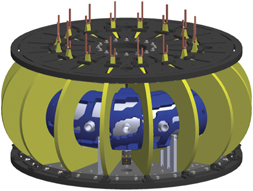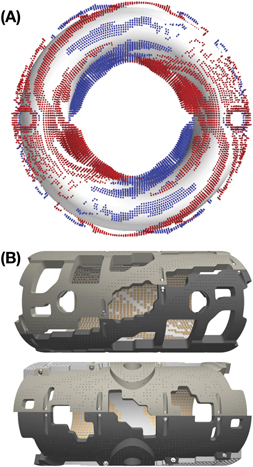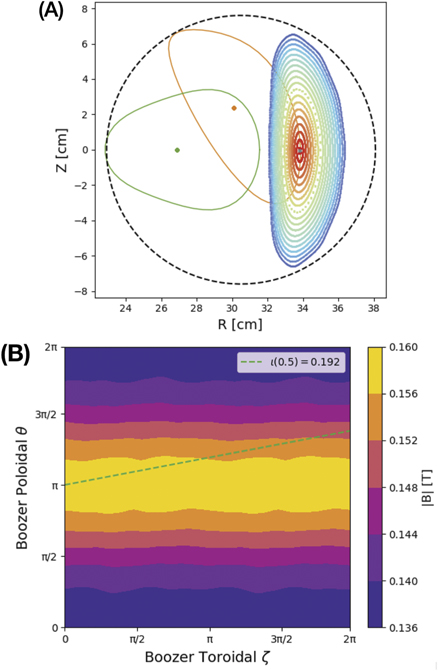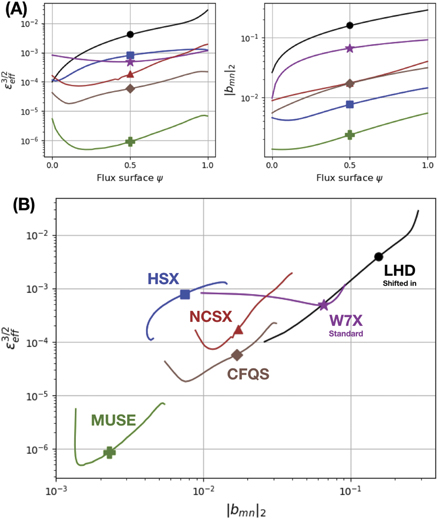Abstract
A first-of-a-kind optimized stellarator for confining plasma has been designed and is being constructed with planar circular coils and permanent magnets composed of identical elements. The equilibrium is optimized to be quasi-axisymmetric for good particle confinement. The combination of permanent magnets and planar coils is significantly simpler to construct than fabricating three-dimensionally shaped coils, yet they are able to produce lower helical magnetic ripple than existing devices by two orders of magnitude in  , a characteristic neoclassical transport metric.
, a characteristic neoclassical transport metric.
Export citation and abstract BibTeX RIS
Stellarators are three-dimensionally shaped non-axisymmetric magnetic tori. They confine fully ionized plasma for controlled fusion, are inherently steady-state, and can operate without externally driven plasma current. This increases the system efficiency and reduces sources of plasma instabilities. The Wendelstein 7-X experimentally demonstrated that numeric optimization of stellarators successfully improves plasma confinement [1]. Optimized three-dimensional magnetic shaping requires complex three-dimensional coils, which remains one of the main challenges for stellarators [2]. The coil structures reduce the apertures for maintenance access to the diverter and internal components. Coil complexity increases costs and was a significant factor in the cancellation of NCSX [3] and the delay of W7-X [4]. As a consequence, simplification of coils has long been identified as a high priority for the stellarator approach to fusion energy.
This letter is about a new approach: simplification of stellarator coils by using permanent magnets (PM) to generate optimized stellarator configurations. An earlier paper [5] introduced the concept of PM stellarators. Here, we present (1) a general approach for simple and low-cost construction of optimized stellarators; and (2) a specific design using this technique for a highly optimized experiment which improves the neoclassical [6] confinement metrics by more than two orders of magnitude relative to existing stellarator experiments.
Permanent magnet stellarators are enabled by modern rare earth magnets [7], which feature high remanence, high coercivity, and low relative permeability (see table 1). Remanence is the magnetic field Br
which appears inside the PM material. The field which appears at the surface of an isolated magnet is actually Br
/2, but this can be increased by using Halbach arrays [8], which manipulate the orientation of neighboring magnets to concentrate the magnetic field on one side of a magnetization layer while canceling it on the other. Coercivity is the external field a PM can resist without demagnetization. Permeability is a measure of how the magnetic field modifies the material's magnetization. This is important for stellarator optimization because low permeability allows the PM array to be optimized as a linearly independent system. For torus-shaped fusion devices the magnetic field quoted typically refers to toroidal field. The poloidal field is smaller by a factor BP/BT = ι , where ι is rotational transform and
, where ι is rotational transform and  = a/R is the inverse aspect ratio (e.g. in the W7-X stellarator ι ∼ 1 and
= a/R is the inverse aspect ratio (e.g. in the W7-X stellarator ι ∼ 1 and  = 1/10, so BP/BT ≈ 1/10). This benefits PM stellarators because the overall device field can be a factor of 2–5 larger than the field produced by PM, since the toroidal field is larger than the poloidal field. From an engineering point of view, PM only require passive mechanical support, in contrast to the cryostat and cryogenic electrical connections needed for superconducting coils.
= 1/10, so BP/BT ≈ 1/10). This benefits PM stellarators because the overall device field can be a factor of 2–5 larger than the field produced by PM, since the toroidal field is larger than the poloidal field. From an engineering point of view, PM only require passive mechanical support, in contrast to the cryostat and cryogenic electrical connections needed for superconducting coils.
Table 1. Comparison of magnetic properties for two rare earth magnets and soft iron at room temperature. Data taken from figure 3.1 of [10].
| Remanence (T) | Coercivity (T) | Permeability | |
|---|---|---|---|
| N52 | 1.4 | 1.1 | 1.05 |
| SmCo | 1.1 | 0.9 | 1.10 |
| Iron | 2.0 | 10–4 | 5000 |
MUSE is a first-of-a-kind PM stellarator experiment. The PMs are optimized to produce an equilibrium with exceptionally good neoclassical transport metrics using very simple coils. The equilibrium is quasi-axisymmetric (QA) [9], which is predicted to offer improved confinement, but has not yet been achieved or studied in experiment. The device has a major radius of R = 0.3 m and a toroidal field BT = 0.15 T. We use commercial neodymium PM for shaping, planar coils (repurposed from a linear device) for background toroidal field, and a glass vacuum vessel (made from commercial pipe) to allow direct visualization of plasma shaping. Figure 1 shows the toroidal field (TF) coils, permanent magnet holders, and vacuum vessel.
Figure 1. MUSE design schematic: planar TF coils surround the permanent magnet holder (blue) and a symmetric glass vacuum vessel together with the support structure.
Download figure:
Standard image High-resolution imagePermanent magnet arrays are designed to target a specific stellarator equilibrium. The magnets may be oriented either perpendicular to the stellarator boundary, or in a combination of tangentially and perpendicularly oriented magnets. Here, we focus on perpendicular-only arrangements because they are simpler. The design of perpendicular magnets is similar to the design of saddle coils for shaping [11]. Both make use of the 'current potential' on a surface surrounding the plasma [12]. The current potential, measured in units (A), gives the jump in the magnetostatic potential across a magnetization surface. Magnetization, measured in units (A m−1), is a fixed material property for PM. Since magnetization can be interpreted as a dipole moment density, [A/m] = [A ⋅ m2]/[m3], the thickness of a PM layer above a given surface element can be estimated by the magnitude of current potential divided by the PM magnetization. This method is limited by the fact that the current potential is defined on a 2D surface, while a PM necessarily occupies volume with finite thickness. Numerical codes have been developed to design PM stellarator arrays that address finite-volume [13–15], but they do not address other criteria. Any practical magnet array must have discrete instead of continuously varying magnetization strengths, discrete magnet orientations, and physical gaps for support structure between magnets.
The MUSE magnets have uniform shape and strength. The geometric distribution is particularly simple, all magnets are normal to a simple circular cross-section torus. The optimized PM arrangement also minimizes the volume of PM, avoids diagnostic ports on the vacuum vessel, and stays within the 2.5 cm radial clearance between vacuum vessel and TF coil. The arrangement of PM is not unique. Our solution consists of the rectangular prisms with uniform magnetization and constant cross section. The dimensions are L × L × H, with L = 6.4 mm and H is an integer multiple of S = 1.6 mm slices. The maximum height is 14 slices, or 22.2 mm (customary units were adopted, L = 1/4'' and S = 1/16'', because they were most easily available on the market). All dipoles are oriented parallel to the H direction, pointing either straight in or straight out of a circular cross-section torus. PM optimization consisted of two alternating phases: (1) continuous optimization by FAMUS [16], a so-called 'topology optimization' quasi-Newton algorithm; followed by (2) filters that discretize magnet sizes in a new code, which we call FICUS. The filtering works to overcome local minima and force the magnets to have a specific magnetization in a discrete length, suitable for commercial manufacturers. In 'step 1a' FAMUS is run to convergence for a specific weighting of metrics e.g. varying material magnetization to obtain good stellarator metrics, then in 'step 1b' FICUS applies a discrete transformation to achieve a specific metric e.g. that all magnets have equal magnetization. Next, that output is used as the starting point for iteration with 'step 2a' in FAMUS. In this way, alternating runs of continuous optimization in FAMUS and discrete optimization in FICUS converge toward a solution that achieves good plasma metrics from discrete, identical dipoles (the L × L × S magnet slice).
MUSE uses commercial 'N52' neodymium–iron–boron (Nd2Fe14B) PM. The name N52 is a market convention that describes stored magnetic energy in particular units, i.e. BHmax = 52 MGOe. At room temperature, the remnant magnetization is 1.4 T, the coercivity is 1.1 T, and the relative permeability is below 1.05. These values for coercivity and permeability refer to the direction parallel to magnetization, but rare earth magnets are known to be anisotropic. The perpendicular coercivity is larger than the material structural strength (i.e. the magnet will fragment before it is demagnetized) and the perpendicular permeability is approximately 1.15 [17]. However, previous numerical studies on neodymium magnets have found that simulations of anisotropic permeability are quantitatively similar to that of isotropic permeability [18]. The design of MUSE assumed relative permeability μ = 1.0. Our initial calculations show that isotropic μ = 1.05 does not produce significant perturbation. A more complete study will be included in future investigations.
Figure 2(B) displays the PM holders. There are four 90-degree toroidal quadrants composed of two identical pairs. Each quadrant of the magnet support structure is further partitioned into three poloidal subsegments, a larger inboard piece and two identical outboard pieces. Each quadrant is centered on one of four symmetry planes in the two-period configuration [19]. Stellarator symmetry constrains the force between quadrants to point only in the cylindrically radial direction. Structural analysis using ANSYS shows that the strength of high-strength nylon is sufficient for MUSE. The magnet support structure is 3D-printed using the HP multi-jet fusion printing technique. Available 3D printers offer spatial precision sufficient for producing the desired magnetic equilibrium, and prototypes of 3D-printed magnet holders have demonstrated high accuracy and high strength glue-bonds to the PM.
Figure 2. (A) Distribution of PM around vessel. Red and blue indicate the magnet polarity. (B) Magnet holding toroidal quadrants viewed from the outboard mid-plane. The cut-outs provide space for diagnostic ports and for direct view of the plasma.
Download figure:
Standard image High-resolution imageThe sensitivity of stellarator metrics were assessed using stochastic and shape gradient methods [20]. We considered both uncorrelated perturbations to individual magnets such as variation in magnetization strength or orientation, and correlated perturbations to the ensemble such as a systematic translation, rotation, or distortion of the permanent magnet holder. The interior flux surfaces and neoclassical transport metrics were found to be robust to uncorrelated perturbations at least as large as, 5% in magnetization, 3 degrees in orientation, and 1 mm in position. For these error magnitudes, the simulations indicate that the change in  is less than 5%. We attribute this remarkably low sensitivity to the large number of degrees of freedom in this system (∼10 K PMs). To address correlated deviations from assembly, each quadrant is mounted on a five-axis adjustable stage. 3D printing tolerance is a potential source of correlated perturbations. To address this we chose an accurate 3D printing process and measured the deviations using laser metrology. Modeling indicated that this scale of deviation has negligible effect on the optimization metrics.
is less than 5%. We attribute this remarkably low sensitivity to the large number of degrees of freedom in this system (∼10 K PMs). To address correlated deviations from assembly, each quadrant is mounted on a five-axis adjustable stage. 3D printing tolerance is a potential source of correlated perturbations. To address this we chose an accurate 3D printing process and measured the deviations using laser metrology. Modeling indicated that this scale of deviation has negligible effect on the optimization metrics.
The plasma equilibrium was optimized using STELLOPT [21] to exhibit good quasi-axisymmetry and minimize effective helical ripple. The effective helical ripple  is a well regarded neoclassical transport metric, proportional to particle flux in the 1/ν regime (see equations (26)–(31) in [22]). A flux surface is quasi-symmetric when the scalar magnetic field magnitude |B| has a direction of symmetry while the vector field B is non-symmetric [23], and quasi-axisymmetry is a special case when the ignorable coordinate follows the toroidal direction. This property is predicted to convey tokamak-like transport to stellarators. In addition to confining drift orbits, it also enables flow in the symmetry direction, which may be important for turbulence optimization.
is a well regarded neoclassical transport metric, proportional to particle flux in the 1/ν regime (see equations (26)–(31) in [22]). A flux surface is quasi-symmetric when the scalar magnetic field magnitude |B| has a direction of symmetry while the vector field B is non-symmetric [23], and quasi-axisymmetry is a special case when the ignorable coordinate follows the toroidal direction. This property is predicted to convey tokamak-like transport to stellarators. In addition to confining drift orbits, it also enables flow in the symmetry direction, which may be important for turbulence optimization.  eff was targeted on three surfaces while QA was targeted at only the half-volume surface (normalized minor radius r ∼ 0.7), following Henneberg [24]. We also targeted a low but finite shear rotational transform profile, and fitting in the vacuum vessel. Low shear avoids low-order rationals that are susceptible to magnetic islands, while finite shear avoids Okuda–Dawson diffusion which can enhance transport in flat-iota stellarators [25]. Our optimization started from a low number of toroidal and poloidal modes and gradually increased the resolution for improved metrics. Several candidate equilibria, optimized from different initial conditions, achieved exceptionally good quasisymmetry and effective helical ripple. We evaluated the candidates to minimize peak PM thickness and thickness on the outboard side. Figure 3(A) shows the plasma shape of the selected configuration, which was initialized from a Garabedian equilibrium [26]. It has two stellarator periods and a plasma aspect ratio of 7.9. In the standard configuration the iota profile increases from 0.182 at the core to 0.197 at the edge, but this can be varied by adjusting the TF coil currents.
eff was targeted on three surfaces while QA was targeted at only the half-volume surface (normalized minor radius r ∼ 0.7), following Henneberg [24]. We also targeted a low but finite shear rotational transform profile, and fitting in the vacuum vessel. Low shear avoids low-order rationals that are susceptible to magnetic islands, while finite shear avoids Okuda–Dawson diffusion which can enhance transport in flat-iota stellarators [25]. Our optimization started from a low number of toroidal and poloidal modes and gradually increased the resolution for improved metrics. Several candidate equilibria, optimized from different initial conditions, achieved exceptionally good quasisymmetry and effective helical ripple. We evaluated the candidates to minimize peak PM thickness and thickness on the outboard side. Figure 3(A) shows the plasma shape of the selected configuration, which was initialized from a Garabedian equilibrium [26]. It has two stellarator periods and a plasma aspect ratio of 7.9. In the standard configuration the iota profile increases from 0.182 at the core to 0.197 at the edge, but this can be varied by adjusting the TF coil currents.
Figure 3. (A) The last closed flux surfaces at the two symmetry planes and a cross section in between  are plotted inside the circular cross section of the vacuum vessel. A Poincare plot shows good fluxes surfaces without magnetic islands. Solid dots mark the magnetic axis at each cross section, and they show a slight torsion. (B) Contours of |B| at the half volume surface (normalized ψ = 0.5). The dashed green line follows a field line with rotational transform ι.
are plotted inside the circular cross section of the vacuum vessel. A Poincare plot shows good fluxes surfaces without magnetic islands. Solid dots mark the magnetic axis at each cross section, and they show a slight torsion. (B) Contours of |B| at the half volume surface (normalized ψ = 0.5). The dashed green line follows a field line with rotational transform ι.
Download figure:
Standard image High-resolution imageThe MUSE stellarator equilibrium has exceptional good quasi-axisymmetry, compared to existing experiments. While many studies describe fixed-boundary VMEC equilibria, here we present data comparing free-boundary representations. Typically free-boundary solutions have worse metrics due to coil ripple, so this highlights the fidelity of our discretized PM array. A metric for quasi-symmetry can be defined as the L2-norm of the symmetric breaking modes

where bmn
are the Fourier modes in Boozer coordinates (normalized to the background field B0), m is the poloidal mode number, n is the toroidal number, and the summation excludes any integer multiple of the desired quasi-symmetric helicity (M, N). Figure 3(B) shows that the contours of |B| are close to straight and aligned toroidally. The 3D neoclassical transport is characterized by the effective ripple  in the 1/ν regime. Figure 4 compares MUSE's effective ripple and quasi symmetry metrics to those of LHD, W7X, HSX, NCSX, and CFQS [27–31]. There are three flavors of quasi-symmetry (QS): quasi-axially-symmetric (QA), quasi-helically-symmetric (QH), and quasi-poloidally symmetric (QP). MUSE, NCSX, and CFQS are QA, while HSX is QH. Although LHD and W7X were not optimized for quasisymmetry, we plot their QP metric after evaluating all three metrics and finding no significant difference. Figure 4 also shows that
in the 1/ν regime. Figure 4 compares MUSE's effective ripple and quasi symmetry metrics to those of LHD, W7X, HSX, NCSX, and CFQS [27–31]. There are three flavors of quasi-symmetry (QS): quasi-axially-symmetric (QA), quasi-helically-symmetric (QH), and quasi-poloidally symmetric (QP). MUSE, NCSX, and CFQS are QA, while HSX is QH. Although LHD and W7X were not optimized for quasisymmetry, we plot their QP metric after evaluating all three metrics and finding no significant difference. Figure 4 also shows that  is a factor of 1000 lower than HSX, LHD, W7-X on the half-volume (normalized toroidal flux ψ ∼ 0.5), and a factor of 100 times lower than NCSX. This level of
is a factor of 1000 lower than HSX, LHD, W7-X on the half-volume (normalized toroidal flux ψ ∼ 0.5), and a factor of 100 times lower than NCSX. This level of  optimization has not been achieved using 3D coils in any constructed stellarator, so far. The MUSE
optimization has not been achieved using 3D coils in any constructed stellarator, so far. The MUSE  is a factor of 60 lower than that of CFQS, which is under construction. Moreover, the effective ripple in MUSE is comparable to that in tokamaks when including the effect of toroidal coil ripple (see figure 15 in [32]). These results highlight the capability of PM to produce highly optimized physics configurations. Recently published results have produced even better quasi-symmetric vacuum equilibria [33] that can be achieved with 3D coils [34]. We do not know of any plans to realize these stellarators in experiment. Finding a MUSE-like PM array for these 'precise-QS' configurations is an interesting path for future work.
is a factor of 60 lower than that of CFQS, which is under construction. Moreover, the effective ripple in MUSE is comparable to that in tokamaks when including the effect of toroidal coil ripple (see figure 15 in [32]). These results highlight the capability of PM to produce highly optimized physics configurations. Recently published results have produced even better quasi-symmetric vacuum equilibria [33] that can be achieved with 3D coils [34]. We do not know of any plans to realize these stellarators in experiment. Finding a MUSE-like PM array for these 'precise-QS' configurations is an interesting path for future work.
Figure 4. Comparison of the effective helical ripple  and quasi-symmetry |bmn
|2 for several experimental stellarators using free-boundary equilibria. (A) Radial profiles for each metric, (B) both metrics parametrized as radial flux functions. Stylized symbols mark the half volume ψ = 0.5 surface and indicate the different devices.
and quasi-symmetry |bmn
|2 for several experimental stellarators using free-boundary equilibria. (A) Radial profiles for each metric, (B) both metrics parametrized as radial flux functions. Stylized symbols mark the half volume ψ = 0.5 surface and indicate the different devices.
Download figure:
Standard image High-resolution imageMUSE plans to conduct e-beam mapping to measure the structure of flux surfaces, and flow damping experiments to measure quasi-axisymmetry. Similar experiments were conducted by Gerhardt et al [35] for quasi-helical symmetry. Low collisionality ν can be achieved in a plasma with low temperature T by using low density n, since the collision frequency ν ∼ n/T3/2. We expect an electron temperature of 1–10 eV and room temperature ions at 0.025 eV. At these temperatures a Hydrogen gyroradius is 0.1 mm, and the electron gyroradius is 0.05 mm, which is small compared to the system size. A plasma density of 1015–1017 particles per m3 puts the electrons in the collisionless regime (ν* ∼ 10−4) and ions in the plateau regime. Slightly heating the ions above room temperature would also push the ions into a collisionless regime.
Stellarator fusion reactors will require large aperture maintenance access and optimized magnetic configurations. This may be satisfied by coils with approximately straight outer legs, in combination with PM on the low field side of the torus. The outboard side requires the least amount of magnetic material in our designs, and the PM would be designed to be demountable. In place of plastic, metal 3D prints could be used for larger stellarators with greater magnetic forces. For higher magnetic field, PM could be combined with related approaches, including diamagnets [36] or saddle coils [37]. There are many types of rare earth PM. By cooling to  K, the coercivity in praseodymium–boron–iron magnets increases to more than 7 T, while the remanence increases to 1.6 T [38]. The Curie temperature is typically above 200 C. This does not present a concern because most fusion reactors plan to deploy super-conducting TF coils at cryogenic temperatures behind neutron shields, and the PM can coexist in that space. Whether or not PM will be used in an economic fusion reactor, they can be used to expeditiously test many stellarator concepts in quick succession. In particular, it may be possible to explore multiple stellarator configurations in a single facility by using different sets of PM on a common set of TF coils and vacuum vessel.
K, the coercivity in praseodymium–boron–iron magnets increases to more than 7 T, while the remanence increases to 1.6 T [38]. The Curie temperature is typically above 200 C. This does not present a concern because most fusion reactors plan to deploy super-conducting TF coils at cryogenic temperatures behind neutron shields, and the PM can coexist in that space. Whether or not PM will be used in an economic fusion reactor, they can be used to expeditiously test many stellarator concepts in quick succession. In particular, it may be possible to explore multiple stellarator configurations in a single facility by using different sets of PM on a common set of TF coils and vacuum vessel.
In summary, we have demonstrated that a highly optimized stellarator can be realized by simple planar coils and PM arranged around a circular cross-section, the simplest possible vacuum vessel. The resulting magnetic configuration is QA and has neoclassical transport metrics two orders of magnitude lower than that in any existing experiment. This approach enables access to precise optimized stellarator configurations, simplifies construction, and reduces costs.
Acknowledgments
The authors are grateful for useful discussions with R. Ellis, M. Landreman, D. Gates, P. Gourdain, K. Hammond, and O. Schmitz. This material is based upon work supported by the US Department of Energy under Contract Number DE-AC02-09CH11466. This material is based upon work supported by the National Science Foundation Graduate Research Fellowship Program under Grant No. 2039656. Any opinions, findings, and conclusions or recommendations expressed in this material are those of the author(s) and do not necessarily reflect the views of the National Science Foundation.







